Bold Move: Presidency Sets Plan to Settle N2tn Power Debt
FG explores new payment options to settle GenCo debts and boost electricity supply

The Presidency has started the internal approval process to settle the N2 trillion power sector debt owed to electricity generation companies (GenCos) before the end of the next quarter, in a major effort to stabilise Nigeria’s troubled electricity supply industry. The move comes after months of warnings from GenCos and growing concerns about the impact of the debt on the nation’s power supply.
At the second Nigerian Electricity Supply Industry (NESI) Stakeholders Meeting of 2025, held in Abuja and hosted by the Nigerian Electricity Regulatory Commission, Eriye Onagoruwa, a representative of the Special Adviser to the President on Energy, confirmed the urgency of the situation. She said the government is exploring alternative debt instruments because of current fiscal constraints, with both the Coordinating Minister of the Economy and the Debt Management Office involved in the process.

“We are empathetic to what GenCos are facing. We are exploring alternative debt instruments, and I can confirm that both the Coordinating Minister of the Economy and the Debt Management Office are aligned with this effort. Internal approvals are currently underway,” Onagoruwa stated.
She expressed hope that a clear update would be available before the next NESI meeting, suggesting that progress could be announced within the next three months.
The GenCos, who supply electricity to the national grid, have repeatedly warned that the growing debt—now over N4 trillion—threatens their operations and the stability of the power sector1. The Senate Committee on Power has also raised concerns, noting that the government owes about N200 billion to power producers every month, with unpaid subsidies and tariff shortfalls adding to the problem.
Minister of Power, Adebayo Adelabu, recently confirmed that the government plans to pay close to N2 trillion out of the N4 trillion owed before the end of the year. The payments will be made through a mix of cash injections and promissory notes, allowing GenCos to access funds more quickly through the banking system.
The NESI Stakeholders Meeting brought together regulators, operators, and other key players to discuss persistent challenges in the sector, including the widening metering gap, the Presidential Metering Initiative, and the establishment of the Nigerian Independent System Operator (NISO). There were also discussions on the transition to a multi-tier electricity market and the new roles for state electricity regulators.
Industry leaders at the meeting welcomed the Presidency’s intervention and expressed optimism that these combined reforms and payments would help reposition Nigeria’s electricity sector for long-term growth and reliability However, they also cautioned that the sector still faces risks, including market fragmentation as states gain more control over electricity regulation.
The acting Managing Director of the Nigerian Bulk Electricity Trading Plc, John Akinnawo, warned that the decentralisation of the market could lead to fragmentation if not properly managed. He urged NISO to ensure policy and operational harmonisation across the country.
Stakeholders agreed that clearing the power sector debt is a critical step towards restoring confidence and attracting further investment. The Presidency’s move is seen as a signal of renewed commitment to sector reform, coming alongside ongoing efforts to expand infrastructure, improve governance, and encourage private sector participation.
Conclusion:
With the Presidency moving to settle the N2 trillion power sector debt, there is renewed hope for stability and improvement in Nigeria’s electricity supply. The coming months will be crucial as the government finalises payment plans and implements broader reforms to ensure a more reliable and sustainable power sector for all Nigerians
Stay woke. Stay tuned. Stay with AKEWE NEWS.




